Peace lilies are some of the most rewarding houseplants to cultivate.
Their glossy leaves add an attractive pop of green to your home year-round, and when they bloom – oh, when they bloom! – it’s deeply rewarding to see that delicate white spathe rising above the foliage.
But how do you keep these plants perfectly watered so that they can thrive? If you’re not sure that you are hydrating your peace lily correctly, this guide will help you out.
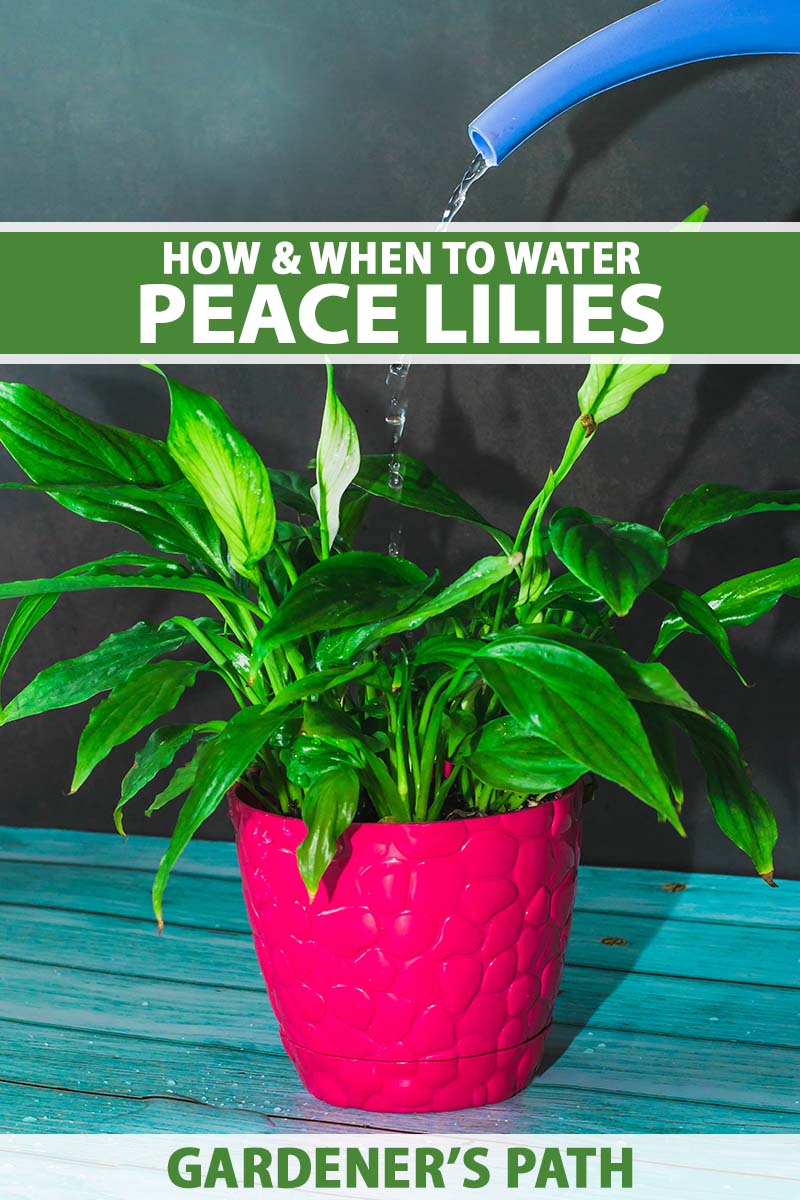
We link to vendors to help you find relevant products. If you buy from one of our links, we may earn a commission.
We’ll cover everything you should know about watering your lovely peace lily.
If you need a refresher on how to grow and care for peace lilies (Spathiphyllum), check out our guide.
Ready to get started?
Here’s what we’ll discuss:
Tips for Watering Peace Lilies
When to Water
Spathiphyllum species tend to be easygoing plants that aren’t usually a challenge to care for indoors.
That said, peace lilies can be picky about moisture levels. In their native environment – tropical areas in Mexico, Central and South America, and Southeast Asia – these plants thrive in evenly moist soil that dries out slightly between waterings.
A lack of moisture will be very apparent as your peace lily will start drooping.
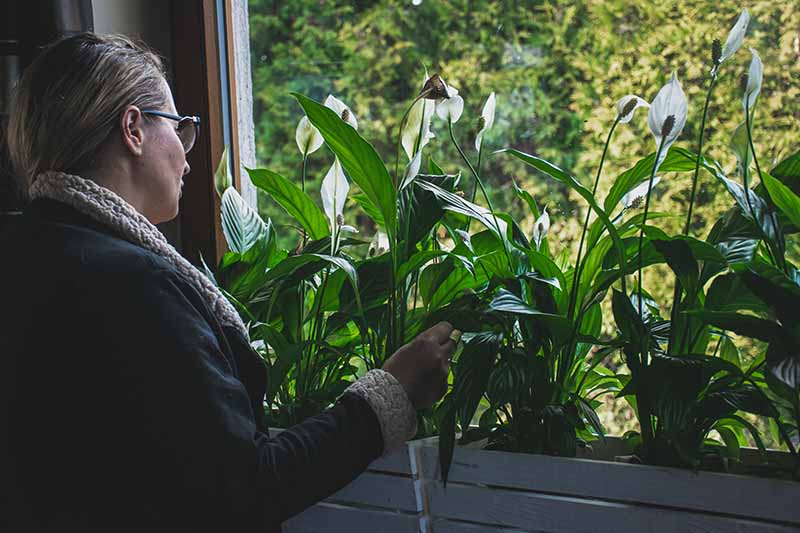
To achieve the ideal moisture level, peace lilies require deep watering about once a week, as a general rule. This will depend on the conditions in your specific location and the type of potting mix your plant is growing in.
You’ll need to check the moisture level every two or three days, by sticking your finger into the top inch of soil. If the soil feels moist, there’s no need to water just yet. But if the top inch feels dry, go ahead and give your plant a deep watering.
Alternatively, you can take the guesswork out of it and use a moisture meter. We have a guide on how to use these handy tools here.
It’s also helpful to note that due to the conditions in their native habitat, peace lilies like humid air. The air in most homes is already less humid than the air outdoors, and in the wintertime, everything becomes even drier.
Consider running a humidifier near your houseplant during the winter months to help prevent brown leaf edges – a sign that your plant may require more humidity.
You can learn more about the causes of brown leaf tips in our guide.
How to Water
To avoid shocking the plant, it’s recommended to use room temperature water when hydrating your peace lily.
Pour it directly on the soil, and try to avoid letting it splash onto the leaves, as repeated splashing can foster conditions that fungal pathogens find favorable. Continue watering until the liquid drains out of the holes in the bottom of the pot.
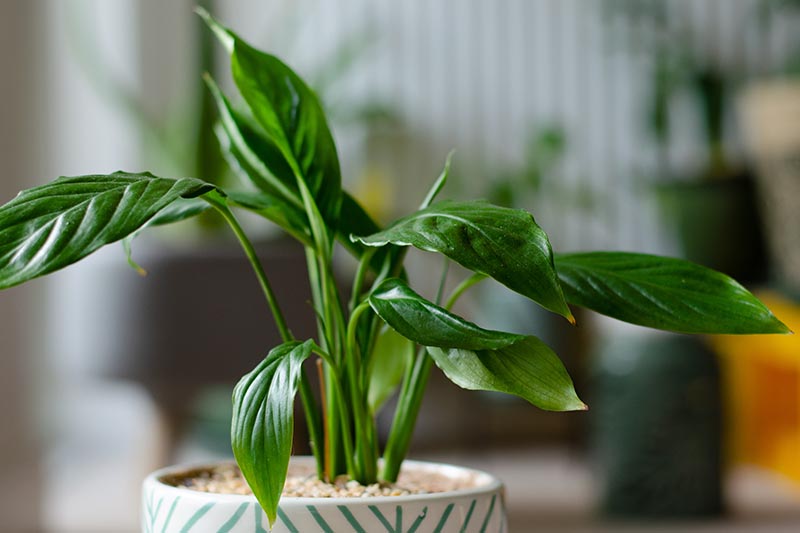
If you wish to try another method, bottom irrigation can work well. This technique allows the potting soil to absorb the moisture it needs and can help prevent overwatering. If you do use this method, you will need to water from above every fourth or fifth time to prevent a build up of salts in the soil.
Whichever method you use, it’s important to make sure that you completely saturate the root ball when you irrigate, according to David Graper, Professor Emeritus of Horticultural Science at the South Dakota State University Extension.
If the root ball doesn’t receive adequate moisture, the plant will suffer. This is why it’s critical to water your peace lily slowly, waiting until water drains out of the bottom of the pot before you stop.
While the roots like to be moist, they will not tolerate soggy, oversaturated conditions, so make sure to dump the water out of the drainage dish or cachepot after ten minutes or so.
If the plant doesn’t receive enough water or the soil becomes too dry in between waterings, it can begin to show signs of stress. The leaves may wilt and start to turn yellow.
Overwatering your Spathiphyllum can result in similar signs of stress: yellowing or browning foliage, brown leaf tips, and a wilted, slumped look.
Learn more about the causes of yellow or brown leaves.
If the plant doesn’t receive the type of hydration it needs, over time the leaves may die and fall off. If you notice that your peace lily is in distress, you’ll need to trim off severely affected leaves with a clean pair of scissors.
Then, assess whether your plant needs more moisture. If the soil feels dry, almost dusty, and is pulling away from the edges of the pot, give it a long, deep watering.
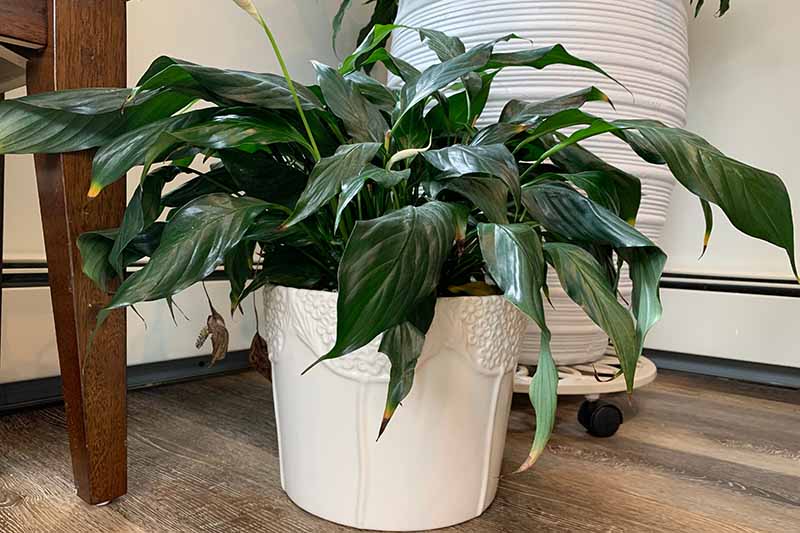
If it feels soggy or soaked to the touch, allow it to dry out at least one inch down before irrigating again. Ensure that the container has adequate drainage holes and that water is able to drain all the way out, and always remember to empty the cachepot or drainage dish!
Peace lilies are sensitive to an excess of chlorine or salt, which can build up in the soil over time. Municipal water from the tap can contain chemicals, minerals, and excess salts, all of which may harm your houseplant.
Additionally, never use softened water, as this contains too much sodium.
If you feel as though you are watering your peace lily correctly but it isn’t looking as vibrant as it should, try using filtered or distilled water, or rainwater instead.
Happily Hydrated
Now that you know more about how to keep your peace lily well watered, you’ll be able to meet its needs and ensure it thrives.
It’s pretty simple: keep the soil evenly moist but not waterlogged, and allow the top inch to dry out between waterings.
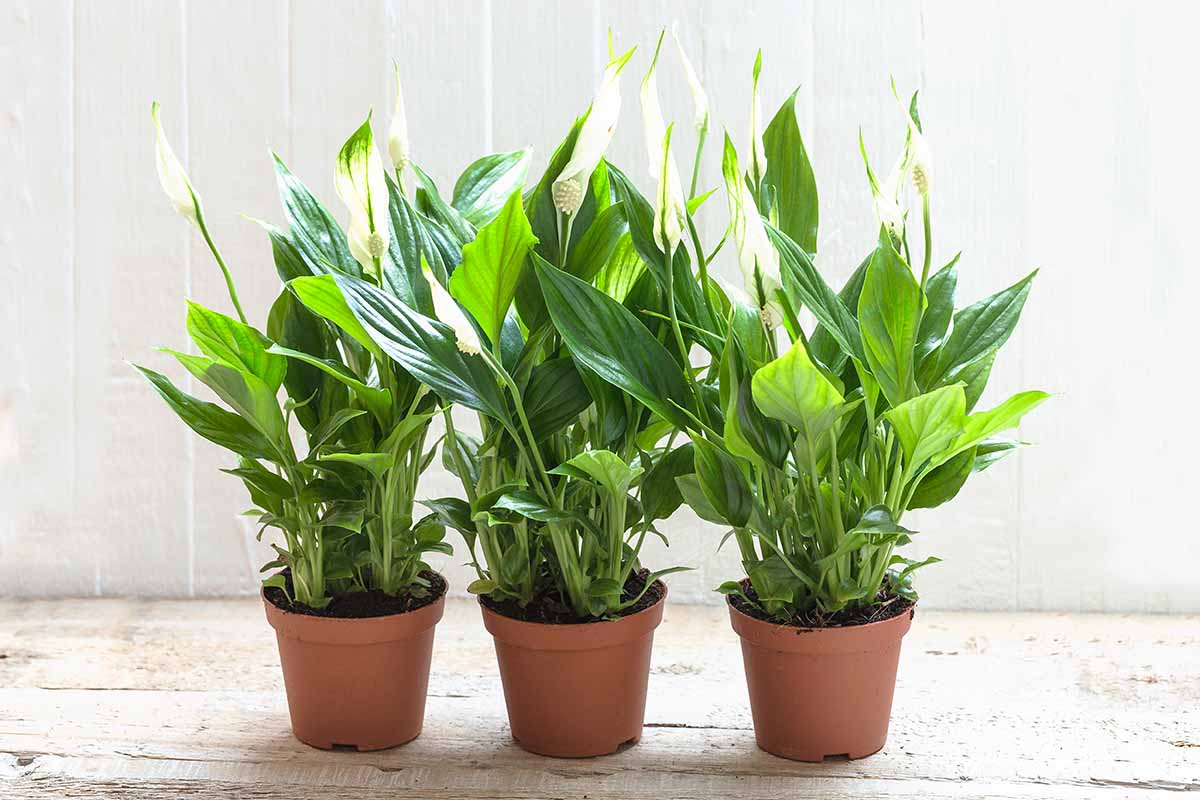
Do you find it difficult to give your houseplants just the right amount of moisture? If you have any stories or struggles, share them in the comments section below. We love to hear from you!
In the meantime, for more information about these easy-care houseplants, have a read of these peace lily guides next:

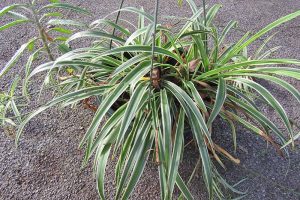

Let me tell you !! Yes Im dramatic & so is my beautiful peace lily one day I came in the house and she was drooping but I had watered her so I decided to give her a mini concert yep you heard me I started singing to her asking her what’s wrong why you acting like that why you drooping what’s the matter with the baby!! do you know after a few minutes her leave sprung back up I can’t believe what they say is so true plants need not just water but love and good vibrations!!
It’s true. We had a talk and hugged it out. I will never say it didn’t help… a lot!
I have had challenges with watering my peace lily over the past 8 years but so far I haven’t killed it. It’s been close a couple of times when “friends” were suppose to water it and forgot. I need to find a watering solution that is not expensive but would provide watering for my peace lily from 5 days to 2+ weeks. I travel some for business especially in the fall, so I need to resolve this problem soon.
Thanks
EJ
Hi Elliot, I always have luck with water bulbs. They work well for short trips like that and don’t under or overwater the soil.
Hi, Thanks for the detailed explanation. I use rain water in a self-watering pot but the tips of the leaves still turn brown. Is self-watering pot recommended for peace lillies?
Hi Ava, I addressed your question on our guide about peace lily leaf tips turning brown.